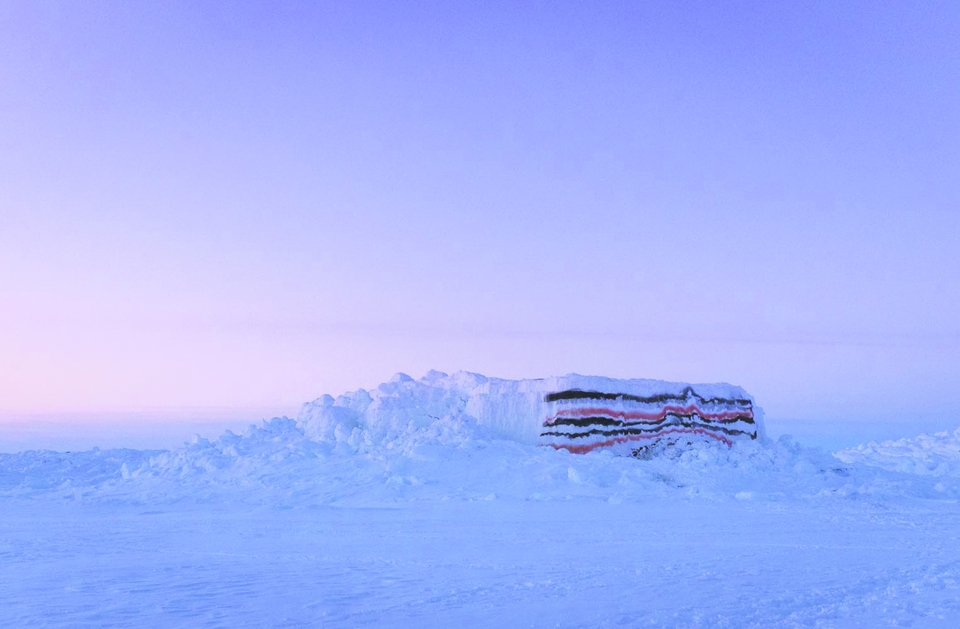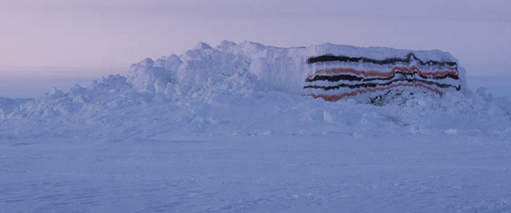I went to pay the parking meter. Several hundred yards, a few dollars and a jog down the steps of the UNM Museum of Art and I walked into a different world than the one I had left. While I was outside, Raven Chacon was syncing the audio and video projectors for one of his latest works, Gauge. The room I left was a blank white, now it glowed an ambient blue as painted ice shelves emerged from the sheet of ocean around Baffin Island and then disappeared again on time-lapsed footage across three walls. The call of alien birds, the slosh of water and the scrape of shifting ice were layered on top of one another in a eerie symphony of what Chacon would call “solitary or rural sound making.”In Lightning Speak, Chacon’s first solo exhibition of independent and collaborative works, he presents a number of “field recordings” given physical shape through various installations, videos, photographs and other documentation. But at the heart of each piece is the aurality of it, tempered with its unique silences. One of Chacon’s first endeavors in sound art was 1999’s Field Recordings, wherein spaces chosen for their quietness were recorded, and that silence amplified to its maximum volume. I approached the wall where Field Recordings was displayed. Three pairs of headphones and three landscape photos spread across the wall—the Sandia Mountains, Window Rock and Canyon de Chelly. I listened to the Sandias first, their rushing sound evocative of wind, something staccato in the texture of it. I listened then to the recordings from Window Rock and Canyon de Chelly, which was perhaps the most striking to my ears, its pitches reaching something more ethereal. “I was surprised by the similarities between [Baffin Island] and these canyons,” Chacon said as we sat down in the middle of the still-under-construction exhibit. “The ice shelves are not that different from these landscapes that first drew me to field recording … I’m interested in how they’re linked, how there’s a common denominator.”“Everything in this room … is an appreciation of silence in an abstract way,” Chacon said. And perhaps that’s what underpins the whole of Lightning Speak—the way the interval between the notes, or its static, pervasive hum adds texture to a landscape and a place in time. “Silence in and of itself is a … component of time … there’s all this information embedded within silence,” he explained. Perhaps silence becomes most charged in Report, a symphony composed for weapons with varying calibers, from shotguns to handguns. Report exists in Lightning Speak as a video installation, having only been performed a handful of times, owing to difficulties in finding locations and performers—a requirement being that the participants not only be skilled with guns, but known how to read music. The imagery is loaded with meaning. The measured discharge of each gun, punctuated by stillness, then the deftness of hands reloading, is fascinating to watch. The rest notes made my heart skip in nervous anticipation—an effect that silence usually doesn’t have. While these pieces carry meaning for Chacon, he insists that his reading doesn’t have to be the one that audiences take away from the exhibit. What is certain is that each of these pieces are charged with meaning, but its up to each viewer to interpret them.“A lot of these are conceptualized as an activation of an experience,” Chacon said. While Report requires precision, many of his pieces are “instructions for an experience” or even more loosely, “guided improvisation.” Take for example, While Contemplating Their Fate in the Stars, The Twins Surround the Enemy. A cage sits in a corner; two zebra finches bob about it. In their cage a theremin— an instrument in which the pitch is controlled by the proximity of the hand, or in this case, the proximity of the birds, to the circuit— emits a steady hum. In relation to the birds’ distance to and from the theremin, its pitch changes. It is both poetry and science to watch them slowly harmonize with the “encroaching presence that the birds realize can be manipulated over time.” Chacon points out that, once set in motion, the content of many of these pieces is totally out of his hands. “We don’t know what’s going to happen. We don’t know how people will react, we don’t know what the birds are going to do … It’s up to the performer to have that experience.” And it’s up to viewers, by proxy participants, to engage with each piece for its duration and contemplate it, divining their own meanings.“What interests me is how sound interacts with a space, how sound can be a performative action but for no audience, the phenomena associated with sound … the things that we don’t know but listen for,” Chacon said. Standing in the space, displays still in protective paper, TVs tuned to a dead channel, my ears prickled with the cumulative noise of every piece in Lightning Speak. “There are no static pieces,” Chacon points out. It slipped passed my awareness as I buzzed about, trying on different headsets, immersing myself in imagery, sound and stories on a loop through time. I could’ve stayed much longer, but, after several hours I was peripherally aware of the parking meter running down. “It’s all about time and the silence inside of that time … and how you can be fluid inside of time,” Chacon told me. I thought about that as I ran up the stairs, boots thudding on the linoleum stairs like a thick metronome.
Lightning Speak: Solo and Collaborative Work of Raven Chacon Jan. 29 through May 14Opening reception Jan. 29 from 6-8pmFreeUNM Museum of Art1 University of New Mexico277-4001, unmartmuseum.org










